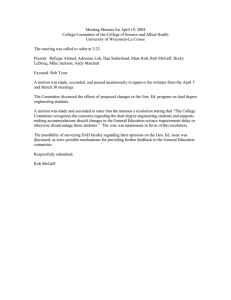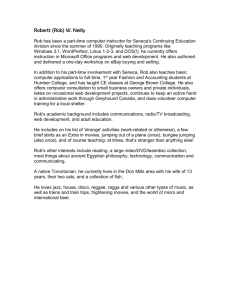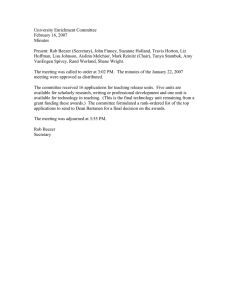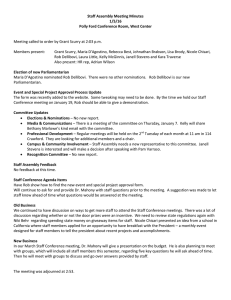NON-CAP WEIGHTED INDEXES
advertisement
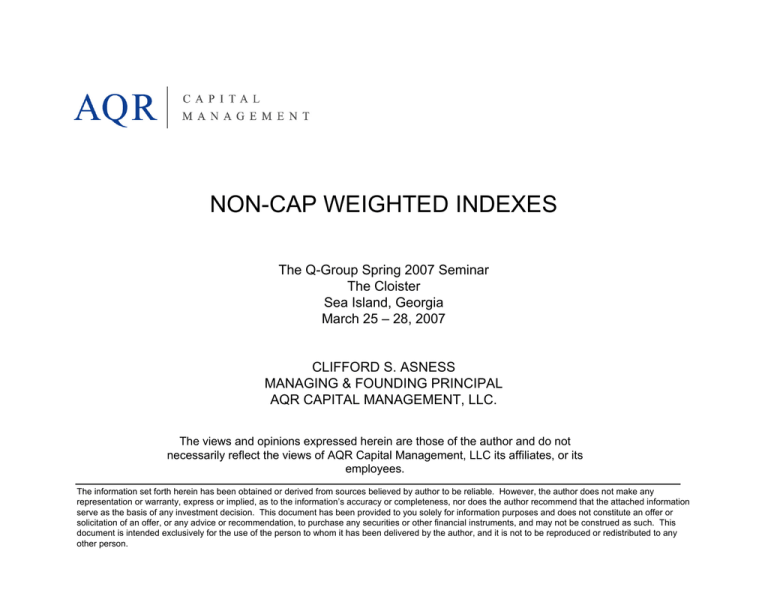
NON-CAP WEIGHTED INDEXES The Q-Group Spring 2007 Seminar The Cloister Sea Island, Georgia March 25 – 28, 2007 CLIFFORD S. ASNESS MANAGING & FOUNDING PRINCIPAL AQR CAPITAL MANAGEMENT, LLC. The views and opinions expressed herein are those of the author and do not necessarily reflect the views of AQR Capital Management, LLC its affiliates, or its employees. The information set forth herein has been obtained or derived from sources believed by author to be reliable. However, the author does not make any representation or warranty, express or implied, as to the information’s accuracy or completeness, nor does the author recommend that the attached information serve as the basis of any investment decision. This document has been provided to you solely for information purposes and does not constitute an offer or solicitation of an offer, or any advice or recommendation, to purchase any securities or other financial instruments, and may not be construed as such. This document is intended exclusively for the use of the person to whom it has been delivered by the author, and it is not to be reproduced or redistributed to any other person. What I’m Saying, And Not Saying • I am not here to challenge Rob on either of these facts – Fundamental Indices have higher expected returns than cap weighted indices – This works, at least in part, because there is noise in prices • I am here to challenge the notion that even one iota of this is new What Will (or did) Rob Say? • Will (or did) he do his standard talk / paper including these highlights? – That FI’s relation to value investing is only “slight”. – The idea that noise driving these effects is a relatively original proposition. – These facts have been suppressed by a vast efficient markets conspiracy, a silence Rob’s heroically breaking. A One Liner • Wi,FI = weight in fundamental index = Bi / BMKT • Wi,CAP = weight in cap weight index = Pi / PMKT W i,FI B i / BMKT ——— = ———— Wi,CAP Pi / PMKT Wi,FI Wi,FI i / BMKT B = ———— Wi,CAP Pi / PMKT B i / Pi = —————— Wi,CAP BMKT / PMKT In Case You Missed The “One” Line Wi,FI B i / Pi = —————— Wi,CAP BMKT / PMKT • FI is precisely, and exactly, and only a value tilt away from cap-weighting. • In particular, a stock with same P/B as the capweighted market is held at the same weight in both. • Tilting based on value already forms the core of most “quant” products • There is literally nothing new here beyond marketing (pretty good marketing actually) False Quibbles With the One Liner Wi,FI i / Pi B = —————— Wi,CAP BMKT / PMKT • Averaging four factors changes nothing. • FI results are often shown allowing a larger universe on FI side. Only way to compare fairly is over same universe. • There are no legit quibbles. The tilt is precisely proportional to your valuation ratios. Rob on Whether It’s Value • “We’ve already noted that critics of Fundamental Indexation dismiss the concept as proxying for the small-cap and value effects. In the large-company arena, this has some slight merit.”* • That he said “some” was not bad enough. But he actually said “slight.” Really. I had to read it twice. * “Fundamental Indexes: Current and Future Applications”, Arnott and West. Underlining is mine. So, Why Am I Upset? • I love value investing, that can’t be it • I don’t yell and scream about the myriad of other value products out there infringing on my obvious sole right to rip-off Fama/French/Graham/Dodd/Etc. • So what is it? The Answer • The FI product does not upset me • Rob’s multiple claims to originality, intellectual heroism, discovery, etc., do upset me a great deal. • His product may or may not be reasonable (based on details of portfolio construction/trading and fees). • His other claims are not reasonable. What Academics Think • Almost all academics, including Fama and French, think markets are not perfectly efficient. • A significant portion of academia believes that markets are non-trivially inefficient. • Those believers are not heretics running from the stake, but some of the biggest / most lauded names in research. What Academics Think II • The belief in market inefficiency held by many academics is the same thing as Rob saying there is “noise” in prices. • This noise has long been one of the prime possible explanations of value’s efficacy. What Academics Think III • For example, Fischer Black’s 1986 AFA presidential address, which he happened to entitle “Noise”, explored the implications of mistakes in security prices. • At least since LSV (1993), noise has been one of the explanations for value. • “Behavioral finance” can be described as the study of the irrationalities that create the noise in security prices. What Rob Thinks • Yet reading Rob’s work you’d think that he is heroically championing the new idea that there is “noise” in prices. • And, that he is doing so in the face of a witheringly oppressive academic thought police. • This is simply not true, it is neither a new idea nor repressed. Rob's Fallback Position • In response to the critique that FI is just value investing, Rob is finally giving a little (he used to fight this harder), but still responds that he has made two very important innovations 1. The idea that “noise” in prices drives this effect (and others). 2. The fact that Fundamental Indexes are constructed without regard to prices means they are not just about value. Why He’s Still Wrong 1. I don’t know how Rob keeps claiming that “noise” driving these effects is a new idea. I just addressed this. I have no model for why Rob keeps claiming this is original. Why He’s Still Wrong 2. Because Rob can write his portfolio down without using prices he says it’s not value. But as a deviation from market cap, it’s precisely a function of relative prices. I think FI is value investing for people who don’t understand ratios. Some Specifics • My general, and by far most important point, is that, despite the grandiose claims, there is nothing new in FI. • But all sorts of specific things also annoy me! • Here are a few. Active is the New Passive* • FI is purely an active value tilt. In the past I have harped on Rob’s use of the word “index” in FI, perhaps too much I admit. • But Rob is sort of implying that this should be a core holding for investors. He thinks it might have a trillion in capacity. • It does not. As an active strategy it’s E[r] goes down as soon as he wins recruits. * I’m stealing this slide title from Tuomo Vuolteenaho. Why Not Call It Active? • If Rob said “I have an active quant value strategy” he’d probably have a harder time selling it as he’d be one of many. • Marketing genius. • By the way, once you embrace “noise” and non cap-weights, why do you stop at value? Why not momentum or other anomalies? Trashing The Russell • Rob argues that FI is not just value because it beats the Russell Value index. • You mean a multiple factor (certainly somewhat data-mined) value bet that delves into a different universe of stocks and may be of entirely different tracking error beats one particular value index. • Wow. I guess I’m wrong. Sorry. It Works Everywhere!! • Rob repeatedly shows FI works everywhere (small, international, to choose countries, each industry, etc.). • Value has already been shown to work for these (many authors over many years). • FI is just value (have I mentioned that?) • This does not stop him from “discovering” it works everywhere. Positives About The Product • FI is value and I like value. • FI tilts each stock continuously (incl. some style timing), uses multiple measures of value, and delves into small stocks. I like all that. Of course, most active value managers already do these things. • It’s a neat way to explain value to a layman. • Now I fear Rob’s takeaway from this talk will be: “Asness endorses FI”. Conclusion • FI is about a 5% (in USA) tracking error four factor quantitative value tilt. It is active quant management circa 1992 sans momentum. • Ultimately it’s practical attractiveness will come down to details of construction, and mainly what fee / tracking error it’s sold at. • Everything else is simply an appropriation and repackaging of others’ work .

